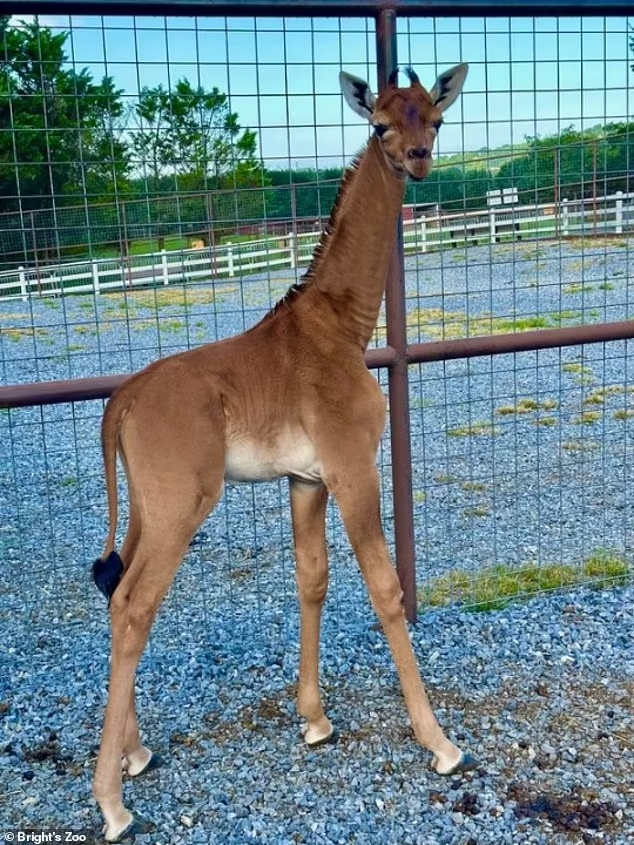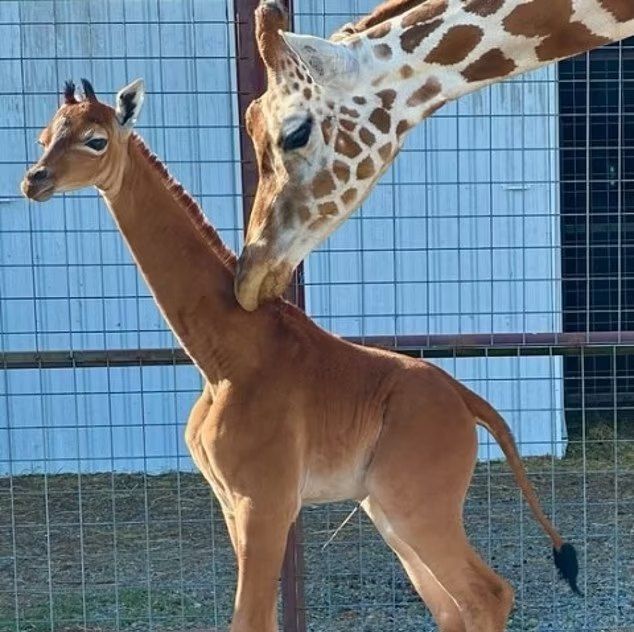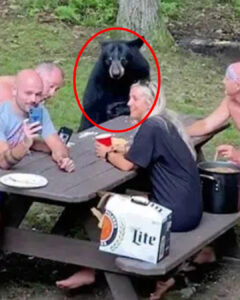It sounds like something straight out of a children’s storybook — a baby giraffe born without a single spot.
But this is no fable. It’s real life, unfolding at Brights Zoo in Limestone, Tennessee, where the world’s only known spotless giraffe is turning heads and melting hearts.
A One-of-a-Kind Birth
On July 31, keepers at Brights Zoo were greeted by something extraordinary: a giraffe calf with a solid brown coat — not a single pattern, blotch, or spot.
The zoo’s director, David Bright, immediately knew they were witnessing something remarkable.
“From day one we’ve been in contact with zoo professionals all over the country,” Bright told WJHL. “And nobody’s seen it — not in decades.”
The calf, a reticulated giraffe (Giraffa reticulata), appears to be the only one of her kind currently alive anywhere on Earth.
The last recorded spotless giraffe was reportedly born in Japan in the 1970s — though no photos have ever surfaced.

Also Read: Giant Octopus Stranded on Beach, Little Girl Saved It by a Smart Plan
Why the Lack of Spots Matters
To most people, a giraffe’s spots are just part of its charm — but in the wild, they’re a matter of survival.
Each giraffe’s patchwork pattern is unique, much like human fingerprints. These markings help camouflage the animal among trees and grass, and may even play a role in temperature control and social communication.
A study once found that calves with larger and more irregularly shaped spots tend to have higher survival rates in their first months of life.
Without spots, a giraffe would stand out to predators — a flashing signal in the open savanna.
That’s why experts believe the spotless calf is safer in the care of Brights Zoo.
Here, she can grow, play, and thrive — without having to hide.
Six Feet Tall and Stealing Hearts
Just weeks after her birth, the baby giraffe already stood six feet tall — graceful, healthy, and curious.
Her mother, a proud reticulated giraffe, has been doting on her from day one. Videos shared by the zoo show the pair nuzzling and walking side by side inside their lush enclosure.
The little one’s deep chestnut coat shines under the Tennessee sun — sleek and unbroken, a smooth contrast to the web of patterns found on her mother.
“She’s truly unique,” Bright said. “And hopefully, she’ll help people fall in love with giraffes again.”
A Global Naming Celebration
To honor her rarity, the zoo decided the world should have a say in her name.
They opened an online vote with four Swahili names, each representing her grace and uniqueness:
-
Kipekee – meaning unique
-
Firayali – meaning unusual
-
Shakiri – meaning she is most beautiful
-
Jamella – meaning one of great beauty
The vote drew global participation, from animal lovers to conservationists, all eager to celebrate a creature that may never be seen again in our lifetime.
Full Story: Elephants Curl Up for a Sleep, Protective Ring Around Baby Elephant in the Middle of Herd
More Than a Miracle — A Wake-Up Call
While the baby giraffe’s spotless beauty has captivated millions, zoo officials hope her fame will shine light on something larger: the quiet crisis facing wild giraffes.
Over the last 30 years, Africa’s giraffe population has fallen by nearly 40 percent — a “silent extinction,” according to conservationists.
Today, only around 16,000 reticulated giraffes remain in the wild, scattered across Kenya, Ethiopia, and Somalia.
“People see giraffes and think they’re everywhere,” Bright said. “But they’re disappearing right before our eyes.”
Habitat loss, civil unrest, and poaching have all taken a toll. And because giraffes are quiet, gentle animals, their decline hasn’t drawn the same attention as elephants or rhinos.
That’s why Bright hopes this calf — with her rare coat and viral fame — can do what statistics can’t: make people care.
The Science Behind the Spots
No one yet knows why this calf was born spotless.
It could be a genetic mutation, or possibly a recessive trait that surfaced after generations.
Experts studying her believe her smooth coat might hold clues about giraffe genetics and evolution.
Each spot normally forms from pigment cells called melanocytes, distributed in the embryo. If that process falters, the result could be a uniform color — nature’s rare experiment.
The zoo plans to share her DNA data with researchers studying coat pattern inheritance in wild giraffe populations.
The Power of Wonder
In a time when much of the news about wildlife feels grim, the arrival of a spotless giraffe feels like a reminder — that nature still surprises us, and still creates beauty in the most unexpected ways.
As visitors gather at Brights Zoo, children stare wide-eyed at the tall, elegant calf with the chocolate-brown coat.
“She’s perfect just as she is,” one visitor said softly.
And maybe that’s the quiet message this baby brings: that difference itself can be its own kind of magic.

What Comes Next
Once she’s named, the spotless giraffe will become a central figure in Brights Zoo’s giraffe conservation program.
The zoo is already working with partners to raise awareness about protecting her species in the wild.
She might be one of a kind — but if her story inspires others to act, she could help save thousands.



